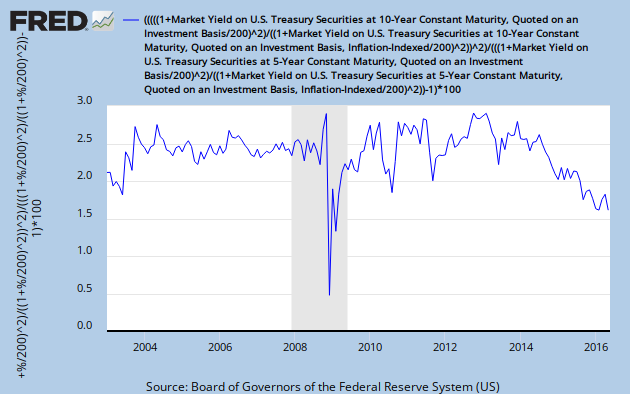
*/*/
I wasn’t surprised to hear in the FOMC minutes that members of the committee thought:
For these reasons, participants generally saw maintaining the target range for the federal funds rate at 1/4 to 1/2 percent at this meeting and continuing to assess developments carefully as consistent with setting policy in a data-dependent manner and as leaving open the possibility of an increase in the federal funds rate at the June FOMC meeting.
and
Participants agreed that their ongoing assessments of the data and other incoming information, as well as the implications for the outlook, would determine the timing and pace of future adjustments to the stance of monetary policy. Most participants judged that if incoming data were consistent with economic growth picking up in the second quarter, labor market conditions continuing to strengthen, and inflation making progress toward the Committee’s 2 percent objective, then it likely would be appropriate for the Committee to increase the target range for the federal funds rate in June. Participants expressed a range of views about the likelihood that incoming information would make it appropriate to adjust the stance of policy at the time of the next meeting. Several participants were concerned that the incoming information might not provide sufficiently clear signals to determine by mid-June whether an increase in the target range for the federal funds rate would be warranted. Some participants expressed more confidence that incoming data would prove broadly consistent with economic conditions that would make an increase in the target range in June appropriate. Some participants were concerned that market participants may not have properly assessed the likelihood of an increase in the target range at the June meeting, and they emphasized the importance of communicating clearly over the intermeeting period how the Committee intends to respond to economic and financial developments.
I was surprised to see some of the markets take it seriously. ?Here’s why:
1)?The FOMC loves to talk hawk and them be doves. ?They don’t think the?costs to waiting are significant, particularly given how low measured inflation and and implied future inflation are. ?Five-year inflation, five years forward implied from TIPS spreads is?not high at present as you can see here:

2) The FOMC is well known for giving with the right hand and taking with the left. ?They would like if possible to have the best of both worlds — gentle movement of what they view as key variables, while usually not dramatically changing the forward estimates of those
3) The FOMC’s natural habitat is wishful thinking. ?Their GDP forecasts are usually high, and they suspect their policy tools will move the economy the way they want and quickly, and it’s just not true.
4) LIBOR rates have done a better job of the FOMC at estimating future policy, and they have barely budged since the FOMC minutes came out.
5) The FOMC always has more doves than hawks, and that is the way the politicians who appoint and approve the board members like it. ?They will live with inflation. ?That was yesterday’s problem. ?Today’s problem is stagnant median incomes — and looser monetary policy will help there, right?
Well, no, but I’m sure they clapped when Peter Pan asked them to save Tinkerbell. ?There is no link between inflation and faster real growth over the long haul. ?There may be measurement errors in the short run.
6) They don’t like moving against foreign rates, but that’s not a big factor.
7) GDP isn’t showing much lift at all.
Summary
Unless we have a change in management at the Fed, where they are?not trying to manipulate markets through their words, but maybe one that said little and acted quietly, like the pre-1986 FOMC, they really aren’t worth listening to. ?They act like politicians. ?Let them study Martin and Volcker, and learn from when the FOMC was more effective.
PS — I’m not saying they can’t tighten in June. ?I’m just saying it’s unlikely, and to ignore the comments in the FOMC minutes. ?What the FOMC says is of little consequence. ?It’s what they do that counts. ?They are like a little dog that barks a lot, but rarely bites.

The dirty little secret of central banking is that monetary policy is asymmetric: it almost always will be effective in curtailing a boom but it will rarely be effective – on its own – in stimulating a recovery. There are countless examples, and many studies to this effect, including the Radcliffe Commission in the UK over fifty years ago, not to mention the last twenty years in Japan and our own recent travails.
Reasonable — and consistent with what others have found in that you can only fool people a little while with money illusion. Add in credit illusion.